Research equipment
Below you find a listing of all available lab equipment within our center. If you would like to utilize any of the equipment listed below, please contact our office for more information.
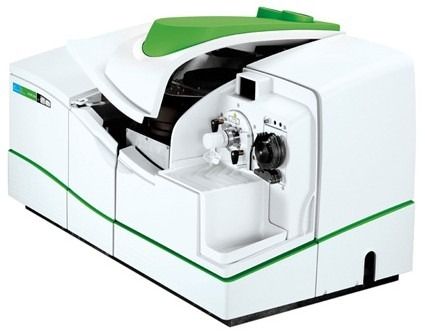
NexION 300 ICP-MS*1
Location: 263 McNutt Hall
NexION 300 ICP-MS*1 209 Schrenk Hall A bench top ICP-MS with single nanoparticle (SP)-ICP-MS function was obtained from PerkinElmer. This ICP-MS is highly sensitive for metal elements and other elements analysis with a specific software system that can be used for single nanoparticle analysis. It not only can detect the trace concentrations of nanoparticles, but also can detect particle size, aggregation and more.

AVIO 200 ICP-OES
Location: 202 Butler Carlton Hall
Inductively Coupled Plasma-Optical Emission Spectrometer (ICP-OES) with liquid autosampler. This model purchased from Perkin Elmer is mainly used for metal elements, and semi-metal elements analysis. Boron (B), silica (Si), phosphorous (P), sulfur (S), and more nonmetallic elements also can be detected. The sensitivity of ICP-OES analysis is not as good as ICP-MS analysis for many elements.

GFAA
Location: 302 Butler Carlton Hall
Graphite Furnace Atomic Absorption Spectrophotometer (GFAA), model Analyst 600, equipped with a model AS800 autosampler was purchased from PerkinElmer. It is mainly used to detect trace level metal and semi-metal elements. The instrument detection limit can reach to part per billion (ppb) for most metal and semi-metal elements, but it can detect only one element each time. Comparing with ICP-MS and ICP-OES, GFAA is more economic to run but takes more time.
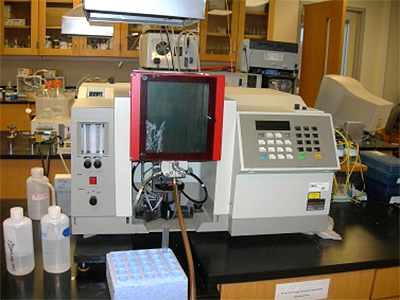
FAA
Location: 302 Butler Carlton Hall
Flame Atomic Absorption Spectrophotometer (model 3110) was purchased from Perkin Elmer. It is used for metal elements analysis. It is a more traditional and reliable analytical instrument with low cost and easy operation features, but its detection limit is higher than that of GFAA and ICP-MS.
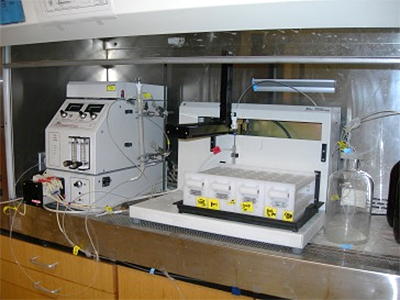
Mercury Analyser
Location: 206 Butler Carlton Hall
Model 2600 CVAFS mercury analysis system with a Model 2620 autosampler purchased from Tekran is used for ultra-low level mercury analysis. The detection limit of this instrument can reach to low part per trillion (ppt) concentrations.
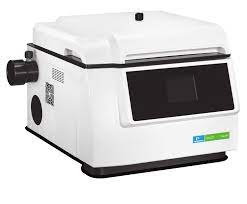
Microwave Digestion System
Location: 202 Butler Carlton Hall
The 16-position pressure vessel Titan MPS microwave has dual magnetrons with 1,500 Watts peak output microwave power delivered in 1% output increments. Designed for rugged, routine laboratory use the system incorporates a stainless-steel outer case, which encloses a cylindrical corrosion-resistant PFA coated oven cavity that ensures homogeneous microwave distribution. Reproducible sample digestion is achieved through precise reaction control of temperature and/or pressure. Access to the sample area from above via a hinged lid offers easy sample access. The system employs 75 mL vessels and allows digestion temperatures up to 260 °C and pressures up to 40 bar.

GC-MS-P&T
Location: 303 Butler Carlton Hall
Gas chromatography-mass spectrometry (GC-MS) with a Purge & Trap (P&T) autosampler and a liquid autosampler. It is an Agilent product. The GC model is 6890 and the Mass Selective Detector model is 5973Network. The purge and trap is a Tekmar-Dohrmann model 3100 Sample Concentrator. This system is mainly used to analyze volatile and semi-volatile organic compounds both quantitatively and qualitatively. The Purge & Trap auto-concentrate/sampler system yields better sensitivity without time consuming sample preparation.
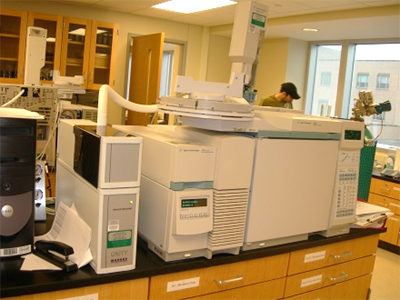
GC-MS-TD
Location: 303 Butler Carlton Hall
Gas chromatography-mass spectrometry (GC-MS) with a thermal desorber (TD) sampler and a liquid autosampler. It is an Agilent product. The GC model is 6890 and MS model is 5973 inert. The thermal desorber is made by Markes International and the model is Unity. This system is mainly used to analyze volatile and semi-volatile organic compounds both quantitatively and qualitatively. The liquid autosampler is used for general liquid injection, and the thermal desorber is used mainly for air sample analysis (air quality monitoring). UNITY’s electrically cooled focusing trap retains ultra-trace volatile components without the use of liquid cryogen. Two, three or even four sorbents can be packed in series for quantitative retention and efficient desorption of wide boiling range samples.
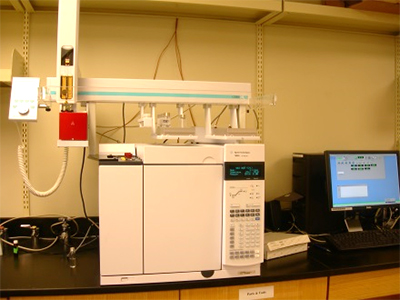
GC-COMBI PAL
Location: 303 Butler Carlton Hall
Gas chromatography (GC) model is 7890 purchased from Agilent Technology. The system is equipped with a flame ionization detector (FID), an electron capture detector (µECD), and a COMBI PAL autosampler. This system is used to analyze volatile and semi-volatile organic compounds. ECD is best for detecting electron-absorbing components (high electronegativity) such as halogenated compounds. FID is best for detecting hydrocarbons and other easily flammable components. The tri-function COMBI PAL autosampler is a product of CTC Analytics and can be used to inject SPME (solid phase micro-extraction), headspace, and liquid samples automatically.

GC-TD
Location: 303 Butler Carlton Hall
Agilent model 6890 Series Gas Chromatograph with a Flame Ionization Detector (FID) and Electron Capture Detector (µECD). This GC is equipped with a liquid autosampler and a UNITY Thermal Desorber with Ultra TD autosampler purchased from Markes International. This system is used to analyze volatile and semi-volatile organic compounds. ECD is best for detecting electron-absorbing components (high electronegativity) such as halogenated compounds. FID is best for detecting hydrocarbons and other easily flammable components. The liquid autosampler is used for general liquid injection, and the Unity-Ultra-TD is used mainly for air sample analysis (air quality monitoring). UNITY’s electrically cooled focusing trap retains even ultra-volatile components without the use of liquid cryogen. Two, three or even four sorbents can be packed in series for quantitative retention and efficient desorption of wide boiling range samples. The Ultra-TD autosampler can load 100 sample tubes in each batch.

GC
Location: 310 Butler Carlton Hall
A Hewlett Packard (HP) model 5890 Series II Gas Chromatograph (GC) with Flame Ionization detector (FID) and Electron Capture Detector (ECD) fitted with a HP model 7673 GC/FSC liquid autosampler and a Tekkmar headspace autosampler. This system is used to analyze volatile and semi-volatile organic compounds. ECD is best for detecting electron-absorbing components (high electronegativity) such as halogenated compounds. FID is best for detecting hydrocarbons and other easily flammable components. The liquid autosampler is used for general liquid injection, and the headspace autosampler is used for headspace injection of solid or liquid samples.

4000Q Trap LC/MSn
Location: 222 Schrenk Hall
An ultra-fast liquid chromatography (UFLC) coupled with a tandem mass spectrometer (MSn). The mass spectrometer is an AB Sciex product and the model is 4000Q Trap. A Shimadzu Prominence UFLC-XR system is used for compound separation with an autosampler. This instrument is used to analyze many trace level compounds including large and small molecules such as proteins, pharmaceuticals and personal care products (PPCPs), water disinfection by-products (DBPs), pesticides and herbicides, explosives, and many more. The detection limits can reach part per billion (ppb) to part per trillion (ppt) for many compounds. It not only can do the quantification of the compounds, also can be used to elucidate some compound structures for qualitative identification by doing MS2 and MS3.
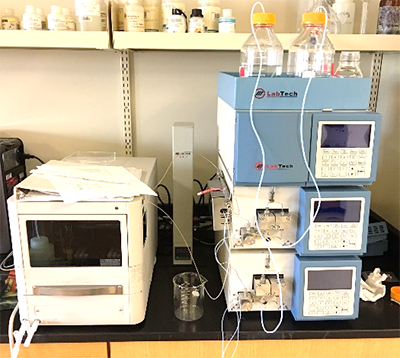
LTA HPLC
Location: 302 Butler Carlton Hall
High performance liquid chromatography (HPLC) system composed with two model P600 pumps, a model UV600 UV-Vis absorbance detector, a Spark model 840 autosampler, and a column oven. It was purchased from LabTech America. This instrument can be used for analysis of compounds absorbing UV-Vis light in wavelength range 190nm-600nm.

Waters HPLC
Location: 302 Butler Carlton Hall
A Waters High performance liquid chromatography (HPLC) system composed with a model 600E controller, a model 60F pump, a model 717 Plus autosampler, a model 996 PDA (photodiode array) detector, and a model 2475 fluorescence detector (FLD). This HPLC is used to analyze those compounds absorbing UV and visible wavelengths light by PDA detector and those compounds fluorescence by FLD.

IC
Location: 302 Butler Carlton Hall
A model DX-120 Ion Chromatography (IC) with a model AS40 autosampler was purchased from Dionex. This instrument is mainly used to analyze anions such as fluoride (F-), chloride (Cl-), nitrate (NO3-), nitride (NO2-), phosphate (PO43-), sulfate (SO43-), and many other anions.
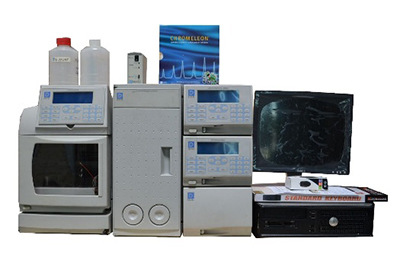
IC 600
Location: 202 Butler Carlton Hall
This IC system with autosampler was purchased from Dionex. It is used to analyze anions such as fluoride (F-), chloride (Cl-), nitrate (NO3-), nitride (NO2-), phosphate (PO43-), sulfate (SO43-), and many other anions.
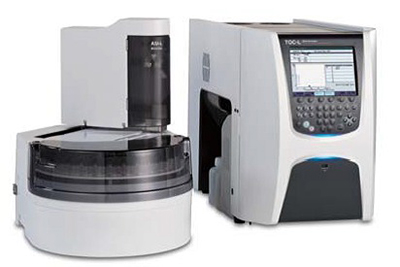
TOC-TN Analyzer
Location: 302 Butler Carlton Hall
Total organic carbon (TOC) analyzer is a Shimadzu product. The system is composed of TOC-L, ASI-L liquid autosampler, solid sample module, nitrogen module and a Whatman model 78-40 gas generator. This instrument is used to detect total organic carbon, total inorganic carbon, and also can detect total nitrogen (TN) in both liquid and solid samples.

Zetasizer
Location: 302 Butler Carlton Hall
The Zetasizer is a product of Malvern, model Nano-ZS90. It is used for particle characterization, including particle size, zeta potential, and iso-electric Point (IP) detection. Suitable particle size range from 0.3nm to 5 microns. The materials include Pharmaceutical dispersions and emulsions, nanoparticles, chemicals – surfactant micelles, colloid size and size distribution, and liposomes/vesicles.
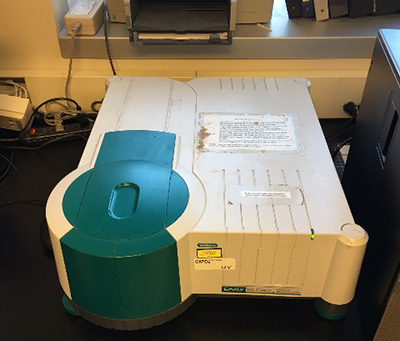
UV-Vis Spectrophometer
Location: 303 Butler Carlton Hall
Model Cary 50 Scanning UV/Vis Spectrophotometer purchased from Varian. This is a very fast scan rate spectrophotometer (can scan the whole wavelength range of 190-1100 nm in less than 3 seconds) can be used to measure the concentration of the compounds absorbing light wavelength in UV and visible ranges, to scan the absorption spectra of the compounds, and to perform kinetic study (data collection rate 80 points/sec).
